-

新人教版高中英语选修2Unit 3 Using langauge-Listening教学设计
1. How is Hunan cuisine somewhat different from Sichuan cuisine?The heat in Sichuan cuisine comes from chilies and Sichuan peppercorns. Human cuisine is often hotter and the heat comes from just chilies.2.What are the reasons why Hunan people like spicy food?Because they are a bold people. But many Chinese people think that hot food helps them overcome the effects of rainy or wet weather.3.Why do so many people love steamed fish head covered with chilies?People love it because the meat is quite tender and there are very few small bones.4.Why does Tingting recommend bridge tofu instead of dry pot duck with golden buns?Because bridge tofu has a lighter taste.5 .Why is red braised pork the most famous dish?Because Chairman Mao was from Hunan, and this was his favorite food.Step 5: Instruct students to make a short presentation to the class about your choice. Use the example and useful phrases below to help them.? In groups of three, discuss what types of restaurant you would like to take a foreign visitor to, and why. Then take turns role-playing taking your foreign guest to the restaurant you have chosen. One of you should act as the foreign guest, one as the Chinese host, and one as the waiter or waitress. You may start like this:? EXAMPLE? A: I really love spicy food, so what dish would you recommend?? B: I suggest Mapo tofu.? A: Really ? what's that?

新人教版高中英语选修2Unit 4 Learning about Language教学设计
This section guides students to pay attention to the typical context of vocabulary use, helps students accumulate vocabulary around the key vocabulary of this unit, and uses the learned words and word chunks in different contexts to deeply understand their meaning and usage, so as to achieve the purpose of review and consolidation.The teaching design activities aim to guide students to pay attention to the typical context in which the target vocabulary is used, as well as the common vocabulary used in collocation, so that students can complete the sentence with correct words. In terms of vocabulary learning strategies, this unit focuses on cultivating students' ability to pay attention to collocation of words and to use word blocks to express meaning.For vocabulary learning, it is not enough just to know the meaning of a single word, but the most important thing is to master the common collocations of words, namely word blocks.Teachers should timely guide students to summarize common vocabulary collocation, such as verb and noun collocation, verb and preposition collocation, preposition and noun collocation, and so on.1. Guide students to understand and consolidate the meaning and usage of the vocabulary in the context, 2. Guide the students to use the unit topic vocabulary in a richer context3. Let the students sort out and accumulate the accumulated vocabulary, establishes the semantic connection between the vocabulary,4. Enable students to understand and master the vocabulary more effectivelyGuiding the Ss to use unit topic words and the sentence patterns in a richer context.

新人教版高中英语选修2Unit 4 Reading for writing教学设计
假定你是英国的Jack,打算来中国旅行,请你给你的中国笔友李华写一封信,要点如下:1.你的旅行计划:北京→泰山→杭州;2.征求建议并询问他是否愿意充当你的导游。注意:1.词数80左右(开头和结尾已给出,不计入总词数);2.可以适当增加细节,以使行文连贯。参考词汇:故宫 the Forbidden City;泰山 Mount TaiDear Li Hua,I'm glad to tell you that 'm going to visit China.First,I am planning to visit Beijing,the capitalof China,where I am looking forward to enjoying the Great Wall,the Forbidden City and somebeautiful parks.Then I intend to go to visit Mount Tai in Shandong Province.I've heard that it is one ofthe most famous mountains in China and I can't wait to enjoy the amazing sunrise there.After that,I amalso going to Hangzhou.It is said that it is a beautiful modern city with breathtaking natural sights,among which the West Lake is a well- known tourist attraction.What do you think of my travel plan? Will you act as my guide? Hope to hear from you soon.

新人教版高中英语选修2Unit 4 Using langauge-Listening教学设计
The theme of the listening section is " talking about scenery and culture along a journey."The part is designed to further lead the students to understand Canadian natural geography and social environment, and integrated into the cultural contrast by mentioning the long train journey from Beijing to Moscow routes. On this basis, the part activates students related travel experience, lets the student serial dialogue, guides the student to explore further the pleasure and meaning of the long journey, and Chinese and foreign cultural comparison.The part also provides a framework for the continuation of the dialogue, which is designed to provide a framework for students to successfully complete their oral expressions, and to incorporate an important trading strategy to end the dialogue naturally.1. Help students to understand and master some common English idioms in the context, and experience the expression effect of English idioms.2. Guide the students to understand the identity of different people in the listening context, and finish the dialogue according to their own experience.3. Instruct the students to use appropriate language to express surprise and curiosity about space and place in the dialogue, and master the oral strategy of ending the dialogue naturally.1. Instruct students to grasp the key information and important details of the dialogue.2. Instruct students to conduct a similar talk on the relevant topic.

新人教版高中英语选修2Unit 5 Learning about Language教学设计
The purpose of this section of vocabulary exercises is to consolidate the key words in the first part of the reading text, let the students write the words according to the English definition, and focus on the detection of the meaning and spelling of the new words. The teaching design includes use English definition to explain words, which is conducive to improving students' interest in vocabulary learning, cultivating their sense of English language and thinking in English, and making students willing to use this method to better grasp the meaning of words, expand their vocabulary, and improve their ability of vocabulary application. Besides, the design offers more context including sentences and short passage for students to practice words flexibly.1. Guide students to understand and consolidate the meaning and usage of the vocabulary in the context, 2. Guide the students to use the unit topic vocabulary in a richer context3. Let the students sort out and accumulate the accumulated vocabulary, establishes the semantic connection between the vocabulary,4. Enable students to understand and master the vocabulary more effectivelyGuiding the Ss to use unit topic words and the sentence patterns in a richer context.Step1: Read the passage about chemical burns and fill in the blanks with the correct forms of the words in the box.

新人教版高中英语选修2Unit 5 Reading and thinking教学设计
The theme of this activity is to learn the first aid knowledge of burns. Burns is common in life, but there are some misunderstandings in manual treatment. This activity provides students with correct first aid methods, so as not to take them for granted in an emergency. This section guides students to analyze the causes of scald and help students avoid such things. From the perspective of text structure and collaborative features, the text is expository. Expository, with explanation as the main way of expression, transmits knowledge and information to readers by analyzing concepts and elaborating examples. This text arranges the information in logical order, clearly presents three parts of the content through the subtitle, accurately describes the causes, types, characteristics and first aid measures of burns, and some paragraphs use topic sentences to summarize the main idea, and the level is very clear.1. Guide students to understand the causes, types, characteristics and first aid methods of burns, through reading2. Enhance students’ ability to deal withburnss and their awareness of burns prevention3. Enable students to improve the ability to judge the types of texts accurately and to master the characteristics and writing techniques of expository texts.Guide students to understand the causes, types, characteristics and first aid methods of burns, through readingStep1: Lead in by discussing the related topic:1. What first-aid techniques do you know of ?CPR; mouth to mouth artificial respiration; the Heimlich Manoeuvre

新人教版高中英语选修2Unit 5 Using langauge-Listening教学设计
The theme of this section is to learn how to make emergency calls. Students should learn how to make emergency calls not only in China, but also in foreign countries in English, so that they can be prepared for future situations outside the home.The emergency telephone number is a vital hotline, which should be the most clear, rapid and effective communication with the acute operator.This section helps students to understand the emergency calls in some countries and the precautions for making emergency calls. Through the study of this section, students can accumulate common expressions and sentence patterns in this context. 1.Help students accumulate emergency telephone numbers in different countries and learn more about first aid2.Guide the students to understand the contents and instructions of the telephone, grasp the characteristics of the emergency telephone and the requirements of the emergency telephone.3.Guide students to understand the first aid instructions of the operators.4.Enable Ss to make simulated emergency calls with their partners in the language they have learned1. Instruct students to grasp the key information and important details of the dialogue.2. Instruct students to conduct a similar talk on the relevant topic.Step1:Look and discuss:Match the pictures below to the medical emergencies, and then discuss the questions in groups.
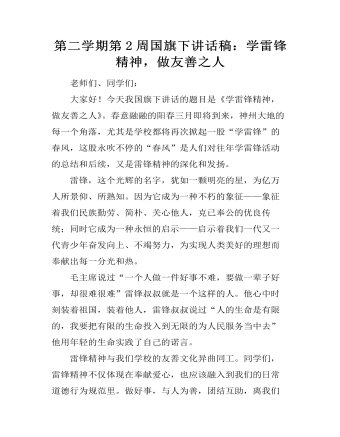
第二学期第2周国旗下讲话稿:学雷锋精神,做友善之人
老师们、同学们:大家好!今天我国旗下讲话的题目是《学雷锋精神,做友善之人》。春意融融的阳春三月即将到来,神州大地的每一个角落,尤其是学校都将再次掀起一股“学雷锋”的春风,这股永吹不停的“春风”是人们对往年学雷锋活动的总结和后续,又是雷锋精神的深化和发扬。雷锋,这个光辉的名字,犹如一颗明亮的星,为亿万人所景仰、所熟知。因为它成为一种不朽的象征——象征着我们民族勤劳、简朴、关心他人,克已奉公的优良传统;同时它成为一种永恒的启示——启示着我们一代又一代青少年奋发向上、不竭努力,为实现人类美好的理想而奉献出每一分光和热。毛主席说过“一个人做一件好事不难,要做一辈子好事,却很难很难”雷锋叔叔就是一个这样的人。他心中时刻装着祖国,装着他人,雷锋叔叔说过“人的生命是有限的,我要把有限的生命投入到无限的为人民服务当中去”他用年轻的生命实践了自己的诺言。
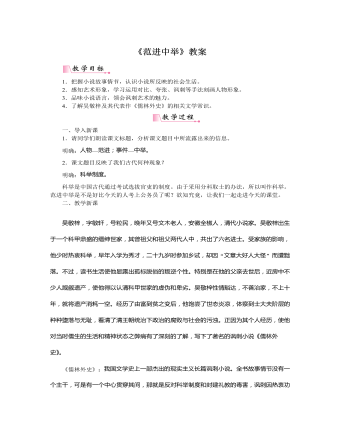
部编版语文九年级上册《范进中举》教案
目标导学一:了解作者,了解作品吴敬梓,字敏轩,号粒民,晚年又号文木老人,安徽全椒人,清代小说家。吴敬梓出生于一个科甲鼎盛的缙绅世家,其曾祖父和祖父两代人中,共出了六名进士。受家族的影响,他少时热衷科举,早年入学为秀才,二十九岁时参加乡试,却因“文章大好人大怪”而遭黜落。不过,读书生活使他显露出孤标脱俗的叛逆个性。特别是在他的父亲去世后,近房中不少人觊觎遗产,使他得以认清科甲世家的虚伪和卑劣。吴敬梓性情豁达,不善治家,不上十年,就将遗产消耗一空。经历了由富到贫之变后,他饱尝了世态炎凉,体察到士大夫阶层的种种堕落与无耻,看清了清王朝统治下政治的腐败与社会的污浊。正因为其个人经历,使他对当时儒生的生活和精神状态之弊病有了深刻的了解,写下了著名的讽刺小说《儒林外史》。

部编版语文九年级上册《我爱这土地》教案
目标导学四:赏析作品,把握诗歌艺术特色1.这首诗在结构上共分两节,请简要说说两节诗歌各有什么特点及它们之间的内在联系。明确:诗的第一节是从虚拟的视角,即从鸟儿的视角去想象,去表现鸟儿对土地的忠诚与挚爱,显得形象含蓄;第二节却换成实写的视角,即从作者自我的视角去实写自己“常含泪水的眼睛”,倾诉自己对土地的“深沉”之爱,是直抒胸臆。这样,虚境和实境的结合与对应,构筑了全诗内在完整的艺术空间;结果与原因的关联与对照,又构成了支撑全诗的内在逻辑结构。此外,从手法特点上看,第一节用的是比,是想象的境界;第二节则是直抒胸臆的写实。全诗由前面蒙太奇镜头式的画面暗示转到了后面作者的直接指点,以一个强有力的情感抒发结束了全篇,从而把注意力引到一个浓郁的情感氛围中,再一次感受到作者对土地的忠贞与挚爱。
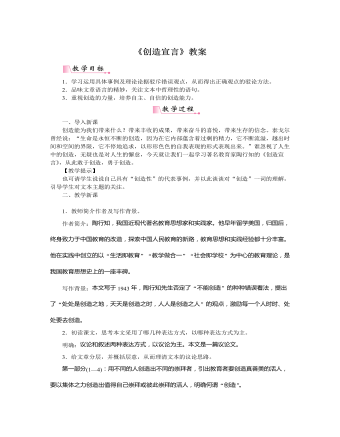
部编版语文九年级上册《创造宣言》教案
1.学习运用具体事例及理论论据驳斥错误观点,从而得出正确观点的驳论方法。2.品味文章语言的精妙,关注文本中哲理性的语句。3.重视创造的力量,培养自主、自信的创造能力。一、导入新课创造能为我们带来什么?带来丰收的成果,带来奋斗的喜悦,带来生存的信念。泰戈尔曾经说:“生命是永恒不断的创造,因为在它内部蕴含着过剩的精力,它不断流溢,越出时间和空间的界限,它不停地追求,以形形色色的自我表现的形式表现出来。”谁忽视了人生中的创造,无疑也是对人生的懈怠,今天就让我们一起学习著名教育家陶行知的《创造宣言》,从此敢于创造,勇于创造。【教学提示】也可请学生说说自己具有“创造性”的代表事例,并以此谈谈对“创造”一词的理解,引导学生对文本主题的关注。二、教学新课目标导学一:初读课文,整体感知1.教师简介作者及写作背景。
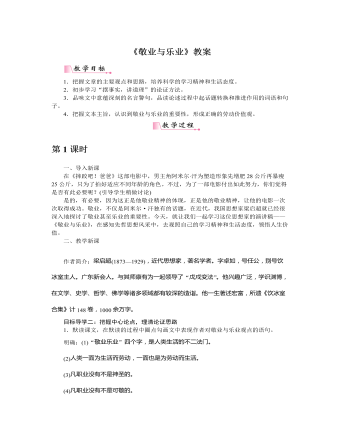
部编版语文九年级上册《敬业与乐业》教案
一、导入新课在《摔跤吧!爸爸》这部电影中,男主角阿米尔·汗为塑造形象先增肥28公斤再暴瘦25公斤,只为了拍好适应不同年龄的角色。不过,为了一部电影付出如此努力,你们觉得是否有此必要呢?(引导学生稍做讨论)是的,有必要,因为这正是他敬业精神的体现,正是他的敬业精神,让他的电影一次次取得成功。敬业,不仅是阿米尔·汗独有的话题,在近代,我国思想家梁启超就已经很深入地探讨了敬业甚至乐业的重要性。今天,就让我们一起学习这位思想家的演讲稿——《敬业与乐业》,在感知先哲思想风采中,去观照自己的学习精神和生活态度,领悟人生价值。二、教学新课目标导学一:认识作者作者简介:梁启超(1873—1929),近代思想家,著名学者。字卓如,号任公,别号饮冰室主人。广东新会人。与其师康有为一起领导了“戊戌变法”。他兴趣广泛,学识渊博,在文学、史学、哲学、佛学等诸多领域都有较深的造诣。他一生著述宏富,所遗《饮冰室合集》计148卷,1000余万字。
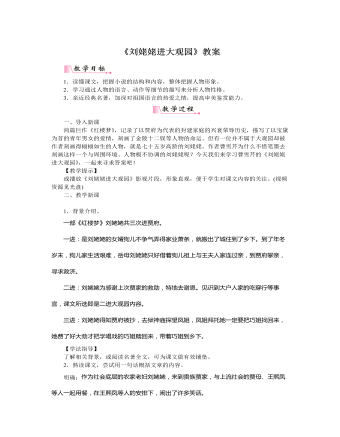
部编版语文九年级上册《刘姥姥进大观园》教案
2.这篇课文细致地描写了各具情态的笑,给人留下了难忘的印象。请说说主要人物的笑有什么不同,反映了他们怎样的性格特点。明确:凤姐、鸳鸯的笑而不露,反映出她们善于计谋,爱耍小手段、取笑、捉弄人的性格特点;史湘云“掌不住,一口茶都喷出来”,反映出她的率真、爽朗、不受拘束的性格;林黛玉“笑岔了气,伏着桌子只叫‘嗳哟!’”,可见她的笑是极力控制,反映出她含蓄、有教养而又谨慎的性格;宝玉笑时钻到贾母的怀里,反映出他的天真、孩子气,也写出了贾母爱孙之心;探春手里的“茶碗都合在迎春身上”,反映了她率真、爽朗、不受拘束的性格特点,也可以看出她要强的个性;惜春笑得肚子疼,让奶母给揉肠子,反映出她娇气、孩子气;“王夫人笑的用手指着凤姐儿,只说不出话来”,写出王夫人已知道是凤姐导演的,但又不便张扬的心理,也保持了雍容与尊贵。
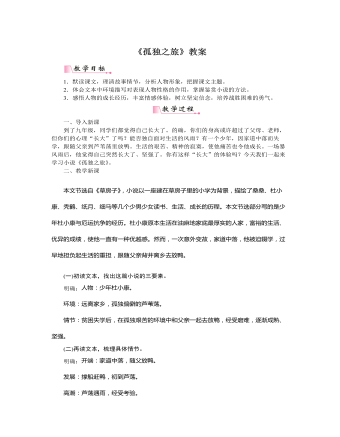
部编版语文九年级上册《孤独之旅》教案
一、导入新课到了九年级,同学们都觉得自己长大了。的确,你们的身高或许超过了父母、老师,但你们的心理“长大”了吗?能否独自面对生活的风雨?有一个少年,因家道中落而失学,跟随父亲到芦苇荡里放鸭。生活的艰苦、精神的寂寞,使他痛苦也令他成长。一场暴风雨后,他觉得自己突然长大了、坚强了。你有这样“长大”的体验吗?今天我们一起来学习小说《孤独之旅》。二、教学新课目标导学一:背景资料本文节选自《草房子》,小说以一座建在草房子里的小学为背景,描绘了桑桑、杜小康、秃鹤、纸月、细马等几个少男少女读书、生活、成长的历程。本文节选部分写的是少年杜小康与厄运抗争的经历。杜小康原本生活在油麻地家底最厚实的人家,富裕的生活、优异的成绩,使他一直有一种优越感。然而,一次意外变故,家道中落,他被迫辍学,过早地担负起生活的重担,跟随父亲背井离乡去放鸭。
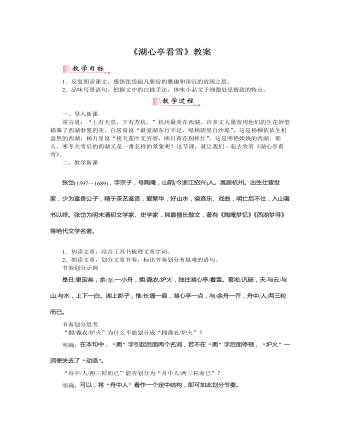
部编版语文九年级上册《湖心亭看雪》教案
一、导入新课常言道:“上有天堂,下有苏杭。”杭州最美在西湖。许多文人墨客用他们的生花妙笔描摹了西湖春夏的美。白居易说“最爱湖东行不足,绿杨阴里白沙堤”,这是杨柳依依生机盎然的西湖;杨万里说“接天莲叶无穷碧,映日荷花别样红”,这是明艳妖娆的西湖。那么,寒冬大雪后的西湖又是一番怎样的景象呢?这节课,就让我们一起去欣赏《湖心亭看雪》。二、教学新课目标导学一:认识作者,了解作品张岱(1597—1689),字宗子,号陶庵,山阴(今浙江绍兴)人。寓居杭州。出生仕宦世家,少为富贵公子,精于茶艺鉴赏,爱繁华,好山水,晓音乐、戏曲,明亡后不仕,入山著书以终。张岱为明末清初文学家、史学家,其最擅长散文,著有《陶庵梦忆》《西湖梦寻》等绝代文学名著。目标导学二:朗读训练,通文顺字1.初读文章,结合工具书梳理文章字词。2.朗读文章,划分文章节奏,标出节奏划分有疑难的语句。节奏划分示例
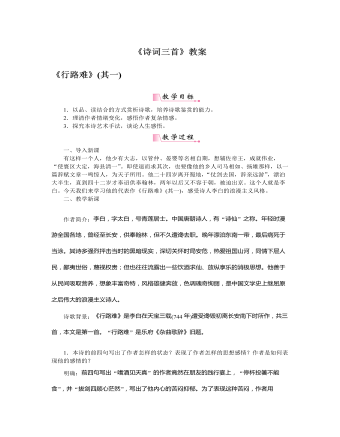
部编版语文九年级上册《诗词三首》教案
一、导入新课有这样一个人,他少有大志,以管仲、晏婴等名相自期,想辅佐帝王,成就伟业,“使寰区大定,海县清一”。即使退而求其次,也要像他的乡人司马相如、扬雄那样,以一篇辞赋文章一鸣惊人,为天子所用。他二十四岁离开蜀地,“仗剑去国,辞亲远游”,漂泊大半生,直到四十二岁才奉诏供奉翰林,两年以后又不容于朝,被迫出京。这个人就是李白。今天我们来学习他的代表作《行路难》(其一),感受诗人李白的浪漫主义风格。二、教学新课目标导学一:认识作者,了解写作背景作者简介:李白,字太白,号青莲居士。中国唐朝诗人,有“诗仙”之称。年轻时漫游全国各地,曾经至长安,供奉翰林,但不久遭谗去职。晚年漂泊东南一带,最后病死于当涂。其诗多强烈抨击当时的黑暗现实,深切关怀时局安危,热爱祖国山河,同情下层人民,鄙夷世俗,蔑视权贵;但也往往流露出一些饮酒求仙、放纵享乐的消极思想。他善于从民间吸取营养,想象丰富奇特,风格雄健奔放,色调瑰奇绚丽,是中国文学史上继屈原之后伟大的浪漫主义诗人。
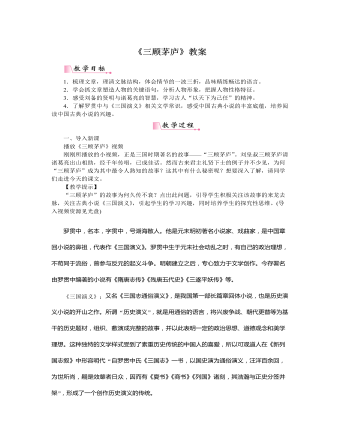
部编版语文九年级上册《三顾茅庐》教案
【教学提示】引导学生分析把握人物的性格特征,在理清人物性格之后,可分角色扮演,还原三顾茅庐情景。角色表演时注意引导学生表现出角色的独特性格。目标导学四:精彩段落研读,解说“隆中对”内容精读“又立了一个时辰,孔明才醒……以成鼎足之势,然后可图中原也”,完成以下问题。1.请你结合全文内容,说一说你对诸葛亮所吟的四句诗的理解。明确:“大梦谁先觉?平生我自知”暗示诸葛亮“未出茅庐,已知三分天下”的雄才大略,“草堂春睡足,窗外日迟迟”写出了诸葛亮淡泊名利。这四句诗为下文故事情节的发展做了铺垫。2.为什么作者安排通过刘备的视线写诸葛亮的相貌?相貌描写片段:玄德见孔明身长八尺,面如冠玉,头戴纶巾,身披鹤氅,飘飘然有神仙之概。明确:一方面写出诸葛亮气宇轩昂,神异不凡,另一方面更加坚定了刘备对诸葛亮的信任,确实有将相之才,又为下文的一再邀请做了铺垫。
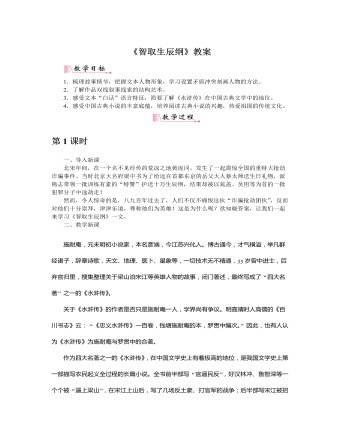
部编版语文九年级上册《智取生辰纲》教案
目标导学二:分析人物形象与环境,探究杨志“失纲”原因1.文中用了大量的笔墨来刻画杨志这一人物,结合文中关于杨志的言行,说说他具有怎样的性格特征,这与他丢失生辰纲有怎样的关系。明确:(1)对路途的凶险有着清醒的认识,根据不同的地形,更改行路的时间。开始是趁凉行路,后来到了“人家渐少,行客又稀”的山路地带,为安全起见,改为“辰牌起身,申时便歇”,天正热时赶路,而且不允许大家在黄泥冈的松林里休息。为防止遭劫,兵士要买酒喝,他又千方百计阻拦。这都充分体现了杨志的精明、小心谨慎的性格特征。(2)杨志对待下属,“轻则痛骂,重则藤条便打”,军汉们“雨汗通流”,苦不堪言,怨声载道。这又体现了杨志粗暴蛮横、刚愎自用的性格特征。杨志的精明谨慎原本不应该产生“失纲”的结果,但是正是因为这份谨慎,才促使他将他的粗暴蛮横、刚愎自用发挥到了极点,以至于内部失和,最后军汉们非要在黄泥冈停住,并买酒中计,从而导致了他的“失纲”。
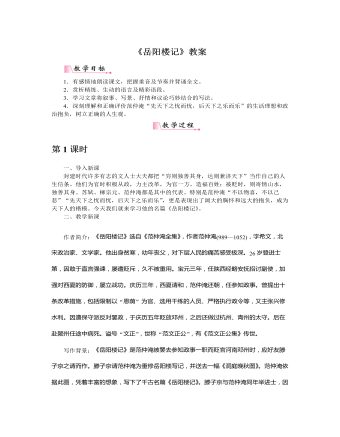
部编版语文九年级上册《岳阳楼记》教案
一、教学新课目标导学一:精读全文,把握文章主旨1.文章第一段写重修岳阳楼的背景,这背景是什么?说明了什么?明确:在“政通人和,百废具兴”的基础上“重修岳阳楼”,这说明滕子京在谪守的逆境中,仍不以己悲,把政事治理得井井有条。由此可见作者欣赏他的阔大胸怀,与一般的“迁客”不同。2.“予观夫巴陵胜状,在洞庭一湖”,作者写出了从岳阳楼看洞庭湖的哪些特点?明确:(1)气势非凡:“衔远山,吞长江”;(2)宽阔无边:“浩浩汤汤,横无际涯”;(3)湖光山色:“朝晖夕阴,气象万千”。3.作者为什么忽然写“前人之述备矣”,从写景中跳出来写人?明确:“前人之述备矣”一句承前启后,并回应前文“唐贤今人诗赋”一语。这句话既是谦虚,也暗含转机,经“然则”一转,引出新的意境,由单纯写景,到以情景交融的笔法来写“迁客骚人”的“览物之情”,从而引出全文的主体。

部编版语文九年级上册《醉翁亭记》教案
一、导入新课范仲淹因参与改革被贬,于庆历六年写下《岳阳楼记》,寄托自己“先天下之忧而忧,后天下之乐而乐”的政治理想。实际上,这次改革,受到贬谪的除了范仲淹和滕子京之外,还有范仲淹改革的另一位支持者——北宋大文学家、史学家欧阳修。他于庆历五年被贬谪到滁州,也就是今天的安徽省滁州市。也是在此期间,欧阳修在滁州留下了不逊于《岳阳楼记》的千古名篇——《醉翁亭记》。接下来就让我们一起来学习这篇课文吧!【教学提示】结合前文教学,有利于学生把握本文写作背景,进而加深学生对作品含义的理解。二、教学新课目标导学一:认识作者,了解作品背景作者简介:欧阳修(1007—1072),字永叔,自号醉翁,晚年又号“六一居士”。吉州永丰(今属江西)人,因吉州原属庐陵郡,因此他又以“庐陵欧阳修”自居。谥号文忠,世称欧阳文忠公。北宋政治家、文学家、史学家,与韩愈、柳宗元、王安石、苏洵、苏轼、苏辙、曾巩合称“唐宋八大家”。后人又将其与韩愈、柳宗元和苏轼合称“千古文章四大家”。

